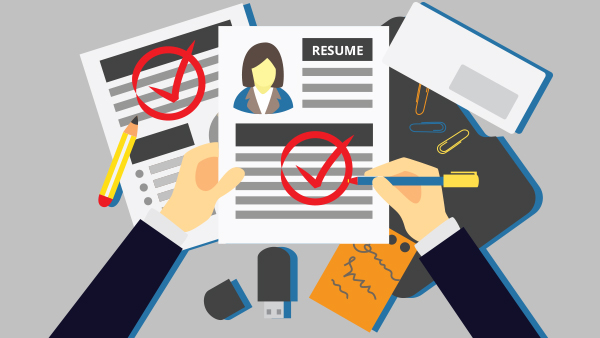CV
Writing the CV: how to introduce yourself to companies

Tips for writing your CV
The curriculum vitae is like a business card to get a first job interview in the company. It is therefore very important to write your CV with attention, care and a bit of strategy.
Here are some tips for doing it right:
- Write the CV in a simple and essential way
The content of the CV should not exceed two folders unless they are senior profiles with very high experience. The sections shown within it must be easily identifiable for easy reading (it would be useful, for example, to increase the line spacing and use different formatting to indicate different topics). Try to take care of the homogeneity of information presentation, to obtain an orderly and clear CV. It is important to remember to include a photograph in the CV. Preferably choose a photo in passport format or in any case a recent, serious and professional image, which can best present you with a view to being considered for a job position.
- Fill in your personal data correctly
To start writing your CV, report your details clearly and without forgetting anything. Enter name, surname, date of birth, city or address of residence and your contact details (number of phone and e-mail address). It is important to indicate that you are willing to transfer if you are applying for positions in other cities or regions.
- Enter route information formative
In order to write the CV correctly, each section must be complete and clearly filled in. It is very important to report all the complete information about the educational path: always enter in full the name of the institution or university where you studied and indicate the exact start and end dates of the courses (also specifying the date and grade of the diploma or degree and the qualifications obtained). Remember that information must always appear from the most recent to the oldest.
- List work experience
Also, in this case, start from the most recent experience, indicating the company name in which you worked and the start and end dates of the employment relationship. Also specify the role, the duties you have been involved in, and the company area of insertion. A good strategy is to customize the list of work experiences according to the recipient, selecting those that could represent an added value in relation to the professional profile sought. Don’t forget to also report any internship experiences!
- Specify language skills
It is increasingly important, in a globalized society, to know some foreign languages, at least English. When writing your CV, therefore, do not forget to indicate your language skills in detail, following the CEFR. Remember to specify the certifications achieved and to report any experiences abroad at the same time.
To write the CV completely, a list of skills cannot be missing. Describe what hard skills have you acquired during previous professional experiences and also refer to the soft skills that distinguish you.

Mistakes to avoid when writing your CV
To write your CV flawlessly, it’s helpful to consider some mistakes you shouldn’t make. Here are the most frequent:
- Grammatical and spelling errors
Spelling errors, even the most trivial ones, can negatively influence the recruiter’s judgment. A careful rereading of the curriculum and the use of the spelling checker of the PC are recommended, which automatically identifies errors and oversights to be corrected.
Omitting the contact details is a very serious mistake, as they are essential in order to be contacted for an interview. Sometimes only the phone number is forgotten, others the e-mail address. An inappropriate or unprofessional email address could be a deterrent to the recruiter, so it is advisable to create an inbox specifically for job hunting.
- Inaccuracies in the history
We have already mentioned it: to write the CV correctly, you must enter the information in reverse chronological order, from the most recent experience to the oldest. Information is often reported confusingly or incompletely. Instead, it is to retrieve official certificates and employment contracts to trace the exact dates of the beginning and end of each course of study or work carried out.
It is very common to use selfies, cropped photos, and inappropriate summer vacation portraits. The photo for the CV must be professional, frame the face, and have a neutral background.
To write the CV you have to be honest. All overestimated skills and inconsistencies with reality will inevitably surface during the interview with the recruiter. In particular, the lies regarding language skills and the reasons with which previous work experiences were concluded are recurrent.
To write your CV and introduce yourself to the recruiters you don’t need to enter an infinite number of hobbies and interests, perhaps completely inconsistent with the position for which you are proposing. It is more useful to focus on all the activities that may have to do with the advertisement to which you reply and constitute an element in favor of the evaluation of your profile.
Differences between hard and soft skills
A very important aspect to consider when writing the CV is the difference between hard skills and soft skills: only through an adequate understanding of the two types of skills can you adequately highlight them on the curriculum and positively influence the recruiter.
Hard skills
These are the technical skills, acquired during the previous training and professional path.
They define the specific professional skills that distinguish workers operating in different sectors, are quantifiable, and can be learned and enhanced through study and experience.
Soft skills
The term “soft skills” generally indicates the transversal skills (literally “light” or “sweet”), which have to do with behaviors and relationships. These skills are complementary to the technical ones, they do not contrast with them but rather integrate them to define a professional profile.
Unlike hard skills, which can be acquired and improved, soft skills are closely intertwined with a person’s innate character and inclinations and prove difficult to learn. For this reason, companies often prefer candidates who, with the same technical skills, have more marked transversal skills.
Soft skills are a strength especially for newly graduated candidates, who, having no professional experience, also lack the technical skills gained in the field.
Here is an overview of the main soft skills, which will allow you to identify what your strengths are and write your resume highlighting them.
- Cognitive
This group includes all the skills concerning ways of thinking and approaching situations, work, and otherwise.
For example, aptitude to problem solving and the skills of analysis and synthesis.
- Relational
They concern the ability to interact and establish relationships with others.
Examples are communication and collaboration skills, customer orientation, negotiation skills, empathy.
- Realization
These include skills related to putting into practice assigned projects and tasks.
Some examples: planning and organization skills, decision-making powers, time management, the spirit of initiative, autonomy, precision.
- Managerial
These are the soft skills that anyone holding a managerial position should possess.
To name a few: leadership, delegation skill, the ability of motivation and coordination of collaborators, authority.
- Transversal
Finally, some basic skills are contextual with others of different categories.
Some examples are flexibility, the ability to manage stressful situations, creativity, the aptitude for updating, resourcefulness.
If you are looking for a job, you should enhance your soft skills, highlighting them when writing your CV. For example, in the European curriculum vitae model, there is an entire paragraph dedicated to personal and communication skills. Remember that when selecting this part could make a difference!
What is the European CV for
The European Curriculum Vitae was created by the European Commission in 2002, to support the possibility for EU citizens to practice their profession in the member states.
The CVE was therefore born as a standardized tool to standardize the curriculum vitae on a European scale, in such a way as to make it clear to foreign employers and recruiters.
The European CV model is characterized by particular graphic formatting, set on two columns, and for a partial pre-compilation of the titles of the thematic sections.
The rules for writing the European CV are essentially the ones we suggested in the first paragraph. Although this is a standard template, fields are all optional and customizable. Don’t forget to delete the field headers you don’t intend to complete! It would be a mistake that could affect the recruiter’s judgment.

Before sending the CV: the cover letter
Also known as a “cover letter”, since it is close to the curriculum vitae, the cover letter is very important and should not be underestimated. In fact, it is a sort of key to access the CV, as has the aim of anticipating the most significant characteristics of the professional profile and entice the recruiter to proceed with the screening of the CV.
Let’s see some tips for writing your cover letter:
- The synthesis first of all
Write a short letter (about 10 lines is the ideal length), summarizing the most important features. Be careful not to overdo the information, which you can detail in your resume. Don’t use bulleted lists and schematic style, opt for a discursive style.
- Break the letter text into 3 parts
To obtain an effective cover letter, it is useful to structure the letter in three parts, which articulate the speech neatly and logically.
- Presentation: you don’t need to repeat your name and surname, specify the position you are applying for, and briefly mention your training and professional profile.
- Reasons for proposing to the company: concisely explain the reasons why you are applying for that specific position, highlight the strengths why they should consider hiring you, and your professional goals.
- Conclusion and thanks: express your willingness to attend an interview, indicate your contact details, and thank you for your attention. Do not forget to enter the authorization for the processing of personal data, as for the CV.
- Personalize the letter from time to time.
Don’t make the common mistake of sending the exact same cover letter to different companies with very different open positions. Always change the account holder and find an element of strength in line with the required profile, which can distinguish you among many applications.
If you send your CV via e-mail, use the cover letter as the body of text and insert a reference to the position you are applying for in the subject.







